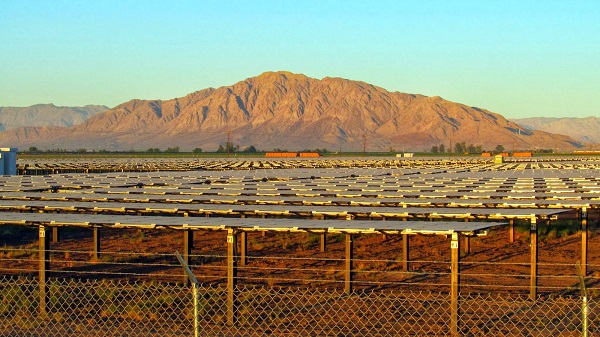Google has made another big green-energy investment, this time pouring $103 million into a huge solar photovoltaic plant in the furthest southern reaches of California.
The latest project the tech behemoth bought into is called Mount Signal Solar, down near the border with Mexico, in Imperial County. Google called it a 265.7 megawatt plant, but that appears to be the DC rating. If that’s indeed the case, with a ballpark derating factor of 0.85, that would put it at 225 MW AC.

In any case, according to California Public Utility Commission documents [PDF], San Diego Gas & Electric has contracted to take 495 gigawatt-hours of generation per year from the plant, with the first deliveries expected to have begun at the end of June this year and full capacity to be reached by the end of this year.
Using 2011 Energy Information Administration data (XLS], which shows the average California home using 567 kilowatt-hours of electricity per month, Mount Signal’s production would be equal to the total amount used by 72,751 homes.
This is another project that is taking advantage of the huge new transmission line that SDG&E completed last year, the Sunrise Powerlink, which runs 117 miles through the desert and over the mountains from the Imperial Valley to San Diego and that cost nearly $1.9 billion to build.
Just last month we outlined several other solar projects that were beginning to pump juice onto the line. Wind power, too, is hooked into it.
In all, SDG&E has agreements in place for renewable energy produced in the Imperial Valley totaling more than 1,200 MW of power. Like the other two big investor-owned utilities in California, Pacific Gas & Electric and Southern California Edison, SDG&E is required by California’s renewable portfolio standard to source increasing amounts of energy from renewable sources, culminating in one-third renewables by 2020.
As for Google, in announcing the investment the company noted that it has made 13 big clean-energy investments in the past three years, totaling more than $1 billion.
“[T]hese projects will generate enough electricity each year to power more than 500,000 U.S. homes,” the company’s head of corporate finance, Kojo Ako-Asare, blogged. “Why are we making these investments? It’s simple: we believe in a clean energy future, and we think that companies like ours can help make it happen. We invest in these projects because they make business sense, because they help put more renewable energy on the grid, and because they have a positive impact on the local economies where they operate.”